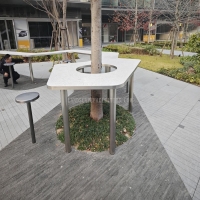Welcome to the website for landscape facilities products and knowledge.
How does the table’s design accommodate the use of tabletop plants or greenery?
Modern table designs have evolved beyond mere functional surfaces to become integrated elements of interior biophilic design. The most innovative tables now incorporate specific features that make plant display both practical and aesthetically pleasing. Many contemporary designs include built-in planters or dedicated greenery zones, often with proper drainage systems hidden beneath decorative layers. These integrated solutions prevent water damage while creating permanent homes for small herbs, succulents, or decorative moss arrangements.
Table surfaces are increasingly designed with materials that resist moisture and scratches, allowing plant containers to be moved without concern for damage. Water-resistant woods with sealed finishes, composite materials, and tempered glass surfaces provide ideal platforms for plant displays. Some designs even incorporate subtle lips or raised edges that contain potential water spills, protecting both the table and surrounding areas.
The structural consideration extends to weight distribution and visual balance. Designers carefully calculate load capacities to support heavier plant arrangements, particularly for tables with center-based planters. The incorporation of greenery has influenced table shapes as well, with oval and organic forms becoming more popular to complement the natural aesthetic of plants. Many modern tables feature open frameworks or lower shelves that allow for taller plants to be incorporated without dominating the visual space.
Lighting integration represents another sophisticated adaptation. Some tables now include subtle LED grow lights beneath upper shelves or within centerpieces, providing necessary illumination for plants while creating ambient lighting effects. This thoughtful integration addresses the practical needs of plants while enhancing the overall atmosphere.
The height and proportion of tables have also been reconsidered to optimize plant placement. Slightly lower table heights create better sight lines across plant arrangements, while taller console tables provide adequate clearance for hanging planters above. These dimensional adjustments ensure that greenery enhances rather than obstructs functional table use.
Through these deliberate design choices, contemporary tables transform from simple furniture pieces into dynamic platforms that bridge interior spaces with natural elements, proving that functional furniture and living greenery can coexist in perfect harmony.
Related search:

Recommendation
An outdoor bar counter with stainless steel and terrazzo materials in an irregular shape